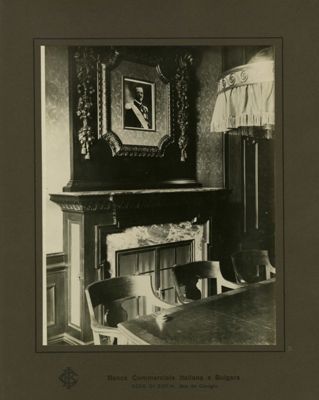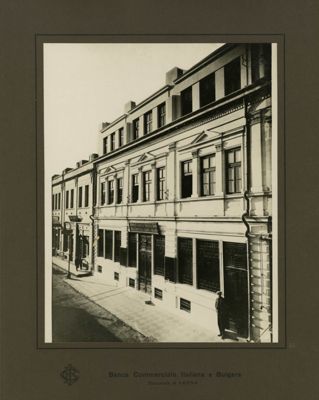| description |
TIMELINE
1919: Banca Commerciale Italiana e Bulgara (Bulcomit), subsidiary of Banca Commerciale Italiana, founded in Sofia.
1948: Bulcomit nationalized.
1974: Banco di Napoli (BN) representative office opened in Sofia through the governmental state enterprise Vitocha.
Banca Commerciale Italiana e Bulgara (Bulcomit, or Italianska y Bulgarska Torgowska Banka) was established in Sofia in 1919 by Banca Commerciale Italiana (BCI), alongside various Bulgaria-based Italians and Bulgarians who together acquired a third of the bank's shares. By the mid-1930s the Holy See had also acquired a stake in the bank.
Bulcomit's aim was to offer every type of banking, commercial, financial and industrial service that would be useful in developing economic relations between Bulgaria and Italy. To this end, it opened branches in Bulgaria's two most important port cities, Varna and Burgas, and also prospered through its financing of the tobacco industry, acquiring a stake in a company called Orientabako in 1921 and setting up a branch in Plovdiv, a major center for tobacco production.
In the latter half of the 1920s, as part of the League of Nations' international loans program (1926, 1928), Banca Commerciale Italiana (BCI) took part in Bulgaria's monetary stabilization process; in 1931 it also opened a credit line for the city of Sofia.
In the 1930s Bulcomit managed to withstand both the economic and financial crisis and growing state intervention in the banking system. Nevertheless, it decided to gradually shut down its activities in the tobacco industry (liquidating Orientabako in 1938) and to sell off a number of minor banks that it controlled more or less directly.
During World War II, due to the terrible damage inflicted on its offices through the Allied bombing raids of Sofia in January and March 1944, Bulcomit transferred its services to other Bulgarian cities: first Nova Zagora, then Pavlovo, and subsequently Pazardzhik and Kamenitza.
The war therefore took a heavy toll on BCI's international presence, including the loss of its Balkan affiliates through the 1947 Peace Treaty. Shortly thereafter, in 1948, Bulcomit was nationalized following the enactment of a law that gave the state a monopoly over the banking sector. In light of Bulcomit's losses, and as part of the Italo-Soviet post-war covenant of December 1948, the Italian government indemnified BCI with a reimbursement for the shares it had held in the bank.
Only Banco di Napoli (BN) would eventually establish a direct presence in Bulgaria, setting up a representative office in Sofia through Vitocha, a Bulgarian state enterprise, in 1974. However, Cassa di Risparmio delle Provincie Lombarde (CARIPLO) also maintained contacts with Eastern Europe by setting up stands, alongside those of BN, at the Plovdiv International Fairs. |
| BIBLIOGRAPHY |
ASI-BCI, Financial Office, Foreign investments, Bulcomit, cart. 10
ASI-BCI, Foreign Service, Managers, Report on Bulcomit by Merzagora, December 1932, cartt. 10-11
ASI-BCI, Miscellaneous Papers of Raffaele Mattioli, cart. 3, f. 3, Study dated 16 October 1933, Part II - "Foreign presence", p. 49
ASI-BCI, Leo Valiani's activities abroad (VAL-E), cart. 1
ASI-BCI, Accounting; Papers of Enrico Righi
ASI-BCI, Financial Statements |


![Banca Commerciale Italiana e Bulgara (Bulcomit), Burgas branch on [16 Boulevard Marie Louise], 1923-1925 (photographer unknown)](/world-map/image-t/IT/ISP/FT00001/0008192/IT.ISP.FT00001.0008192.0001.jpg)
![Banca Commerciale Italiana e Bulgara (Bulcomit), Plovdiv branch on [Rue Kniaz Ferdinand], 1927-1930 (photographer unknown)](/world-map/image-t/IT/ISP/FT00001/0008193/IT.ISP.FT00001.0008193.0001.jpg)
![Banca Commerciale Italiana e Bulgara (Bulcomit), Varna branch on [4 Rue Gabrovska], after 1921 (photographer unknown)](/world-map/image-t/IT/ISP/FT00001/0011457/IT.ISP.FT00001.0011457.0001.jpg)
![Banca Commerciale Italiana e Bulgara (Bulcomit), Varna branch on [4 Rue Gabrovska], after 1921 (photographer unknown)](/world-map/image-t/IT/ISP/FT00001/0011457/IT.ISP.FT00001.0011457.0002.jpg)

